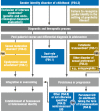Gender identity disorders in childhood and adolescence: currently debated concepts and treatment strategies
- PMID: 19578420
- PMCID: PMC2697020
- DOI: 10.3238/arztebl.2008.0834
Gender identity disorders in childhood and adolescence: currently debated concepts and treatment strategies
Abstract
Introduction: Gender identity disorders (GID) can appear even in early infancy with a variable degree of severity. Their prevalence in childhood and adolescence is below 1%. GID are often associated with emotional and behavioral problems as well as a high rate of psychiatric comorbidity. Their clinical course is highly variable. There is controversy at present over theoretical explanations of the causes of GID and over treatment approaches, particularly with respect to early hormonal intervention strategies.
Methods: This review is based on a selective Medline literature search, existing national and international guidelines, and the results of a discussion among experts from multiple relevant disciplines.
Results: As there have been no large studies to date on the course of GID, and, in particular, no studies focusing on causal factors for GID, the evidence level for the various etiological models that have been proposed is generally low. Most models of these disorders assume that they result from a complex biopsychosocial interaction. Only 2.5% to 20% of all cases of GID in childhood and adolescence are the initial manifestation of irreversible transsexualism. The current state of research on this subject does not allow any valid diagnostic parameters to be identified with which one could reliably predict whether the manifestations of GID will persist, i.e., whether transsexualism will develop with certainty or, at least, a high degree of probability.
Conclusions: The types of modulating influences that are known from the fields of developmental psychology and family dynamics have therapeutic implications for GID. As children with GID only rarely go on to have permanent transsexualism, irreversible physical interventions are clearly not indicated until after the individual's psychosexual development ist complete. The identity-creating experiences of this phase of development should not be restricted by the use of LHRH analogues that prevent puberty.
Keywords: child health; gender identity disorder; hormone treatment; sex change; transsexuality.
Figures

References
-
- Zucker KJ, Bradley SJ. Gender identity disorders and psychosexual problems in children and adolescents. New York, London: Guilford Press; 1995. - PubMed
-
- Bradley SJ, Zucker KJ. Gender identity disorder: a review of the past 10 years. J Am Acad Child Adolesc Psychiatry. 1997;36:872–880. - PubMed
-
- Green R, Roberts CW, Williams K, Goodman M, Mixon A. Specific cross-gender behaviour in boyhood and later homosexual orientation. Br J Psychiatry. 1987;151:84–88. - PubMed
-
- Di Ceglie D. Gender identity disorders in children and adolescents. Br J Hosp Med. 1995;53:251–256. - PubMed
-
- Cohen-Kettenis PT, Owen A, Kaijser VG, Bradley SJ, Zucker KJ. Demographic characteristics, social competence, and behavior problems in children with gender identity disorder: a cross-national, cross-clinic comparative analysis. J Abnorm Child Psychol. 2003;31:41–53. - PubMed
LinkOut - more resources
Full Text Sources
Research Materials

